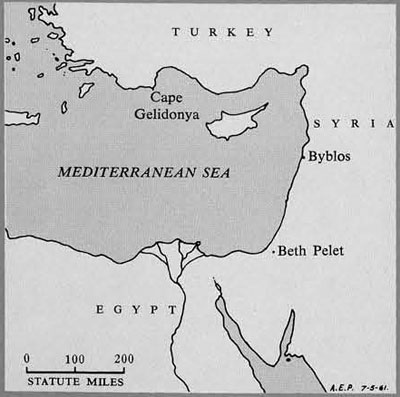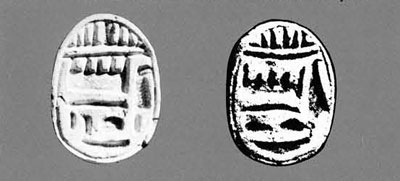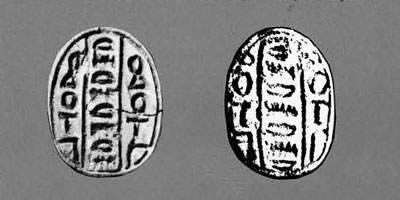 Among the objects recovered last summer by a University Museum expedition from a Bronze Age ship lost off Cape Gelidonya, Turkey* are three Egyptian scarabs which are of value in establishing the date of the wreck. One of the scarabs is of particular significance in this regard. On it, the god Re, represented as a falcon-headed human figure, stands at the left, his right hand hanging down behind him, his left arm terminating in a viper, a symbol of Egyptian kinship, which rears up in front of him. Over the heads of both god and serpent are sun-discs. Beneath the curve where the left arm turns into the serpent’s body is the neb-sign, a hieroglyph representing a wickerwork basket, and which means either “every” of “lord.” In front of the serpent is a long vertical sign which I have not been able to identify.
Among the objects recovered last summer by a University Museum expedition from a Bronze Age ship lost off Cape Gelidonya, Turkey* are three Egyptian scarabs which are of value in establishing the date of the wreck. One of the scarabs is of particular significance in this regard. On it, the god Re, represented as a falcon-headed human figure, stands at the left, his right hand hanging down behind him, his left arm terminating in a viper, a symbol of Egyptian kinship, which rears up in front of him. Over the heads of both god and serpent are sun-discs. Beneath the curve where the left arm turns into the serpent’s body is the neb-sign, a hieroglyph representing a wickerwork basket, and which means either “every” of “lord.” In front of the serpent is a long vertical sign which I have not been able to identify.
This motif of the falcon-headed man is well known. Its prototype is perhaps to be seen in a motif of the Hyskos period (ca. 1675-1567 B.C.). There, however, the figure usually has a human, not a falcon head, and the serpent is held in the left hand and usually, but not always, faces the figure. Scarabs with this motif are found mainly in Palestine, but also in Egypt. By the 18th Dynasty (ca. 1570-1304 B.C.) the motif has assumed the characteristics of the Gelidonya scarab and in this form continues to be used during the early years of the 19th Dynasty (ca. 1304-1200 B.C.). It occurs most frequently on scarabs which can be dated to the reign of Ramesses II (ca. 1290-1223 B.C.). It is not known after the reign of Merenptah (ca.1223-1211 B.C.). Throughout this period there are, of course, some variations. One scarab from the late 18th-early 19th Dynasty shows the king, wearing the Blue Crown, rather than the god; occasionally both hands terminate in serpents; once or twice the figure is shown seated or kneeling. A new variant of the motif appears on a scarab dated to the reign of Ramesses II and continues into the 20th Dynasty; in this a second serpent seems to be growing out of the extended left foot of the figure. A second variant which first appears toward the end of the 19th Dynasty shows a projection seemingly growing obliquely out of the left shoulder of the deity; on several scarabs this projection is clearly a wing.

Scarab from the wreck and a parallel from Beth Pelet. (Below) Chronological arrangement: scarab of the Hyksos Period, scarab from the wreck, parallel, latest development.

Scarab from the wreck and its parallel from Byblos.

Scarab from the wreck and its parallel from Byblos.
The general characteristics of the design of the second scarab from the wreck are very well known from the 18th Dynasty on. The design consists of the name Amon-re, the paramount god of Egypt in the New Kingdom. The name is flanked by teo neb-signs. The iconography of this particular scarab is peculiar, however, in that the topmost neb-sign occupies fully a third of the field and actually forms a portion of the border of the scarab, with the group Amon-re, neb written vertically beneath it. I know of only one other scarab with the design so arranged and that is from Byblos where the stratification is hopelessly confused.
Byblos likewise provides the only close parallel in motif and composition to the third of the Gelidonya scarabs. The design immediately calls to mind the iconography of the scarabs of the Second Intermediate Period (ca. 1785-1567 B.C.). The division of the field into three vertical columns and the crude broad writing of the individual signs are characteristic of that period. However, in the central column there are usually three signs; only in the Gelidonya scarab and in its parallel from Byblos are there only two. The latest of the three scarabs can thus be dated to the 18th or 19th Dynasty, and most probably to the reign of Ramesses II in the 19th Dynasty, when this motif was used the most frequently. This in turn suggests the thirteenth century as the most probably date of the wreck, although a slightly earlier date is possible. Mr. Bass, the excavator of the wreck, tells me that this is in basic accord with the other evidence.
The question of the significance of the distribution of the motifs of the scarabs mainly to sites outside Egypt, in Palestine and Syria, is one for further study. How these particular scarabs came to be on the ill-fated ship arouses our curiosity. They were certainly the personal property of at least one of the members of the crew, but what his origin was must remain in the realm of speculation. He may have been an Egyptian or a Syrian who owned them for religious reasons, or as good luck charms, or he may have been a Cypriote or a Hellene who once brought them back as mementos of a voyage to Egypt or Syria. We can say with certainty that the ship was carrying a load of copper and bronze from Cyprus. A detailed study of the pottery may be decisive in determining the land of origin of the ship or its crew members. The preliminary study shows that some of it is Syrian while the rest is Cypriote. The metal implements and the metal ingots seem mostly Cypriote, but scenes in the Egyptian tomb paintings of the 18th Dynasty show that the Syrians traded copper ingots of the type found on board the wreck into Egypt.
